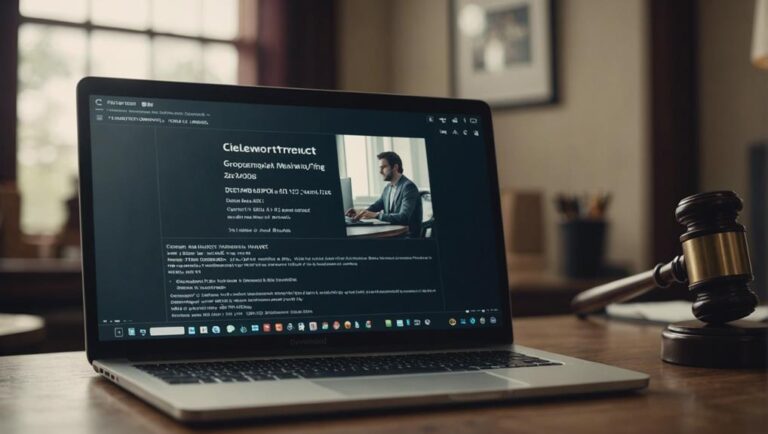Remote Work Security Best Practices
For guaranteeing remote work security, start by utilizing VPNs to encrypt your internet traffic and establish secure data tunnels. Implement multi-factor authentication for added protection, requiring multiple verification methods. Keep your software updated to prevent vulnerabilities and enhance system performance. Utilize robust encryption protocols for data protection both in transit and at rest. Enforce a strong password policy and consider using biometric authentication for extra security. Finally, ensure employee training on cybersecurity awareness to prevent phishing attacks. These practices form a robust foundation for secure remote work.
VPNs for Secure Connections
To guarantee secure connections while working remotely, utilize VPNs to encrypt your internet traffic and protect sensitive information. VPNs offer various security features that are essential for maintaining remote work privacy. One key feature is encryption, where VPNs encode your data to make it unreadable to unauthorized parties. This safeguards that even if your connection is intercepted, your information remains secure.
Another important aspect of VPN security is tunneling. VPNs create a secure tunnel for your data to travel through, shielding it from potential cyber threats. By routing your internet traffic through this encrypted tunnel, VPNs add an extra layer of protection to your online activities.
Moreover, VPNs often come equipped with features like kill switches, which automatically disconnect your device from the internet if the VPN connection drops. This prevents any unencrypted data from being transmitted, maintaining the confidentiality of your information.
Multi-Factor Authentication Implementation
Implementing multi-factor authentication strengthens the security of your remote work setup by requiring multiple forms of verification for accessing sensitive data and systems. Remote access to company resources becomes more secure when you introduce an additional layer of identity verification beyond just a password. This extra step typically involves something you know (like a password), something you have (like a smartphone for receiving a code), or something you are (like a fingerprint or facial recognition).
By combining these factors, multi-factor authentication greatly reduces the risk of unauthorized access even if passwords are compromised.
When setting up multi-factor authentication for remote access, make sure that the verification methods chosen are convenient for your employees while maintaining a high level of security. This could include options such as SMS codes, authenticator apps, hardware tokens, or biometric recognition.
Regularly reviewing and updating the multi-factor authentication settings is important to adapt to evolving security threats and ensure that your remote work environment remains protected.
Regular Software Updates
Ensuring regular software updates on all devices and systems within your remote work environment is essential for maintaining peak security measures. Remote monitoring tools can assist in overseeing the software versions across your network, alerting you to any outdated applications that may pose security risks.
Patch management plays a vital role in this process, as it involves regularly applying updates and patches to address vulnerabilities and enhance system security.
By incorporating remote monitoring solutions, you can efficiently track the software update status of all devices in your remote work setup. This proactive approach enables you to identify potential security gaps promptly and take necessary actions to mitigate risks.
Patch management tools streamline the update process, ensuring that critical patches are applied promptly to protect your systems from cyber threats.
Regular software updates not only enhance security but also improve system performance and stability. By consistently monitoring and managing software patches, you can minimize the likelihood of security breaches and maintain a secure remote work environment.
Data Encryption Protocols
Utilize robust data encryption protocols to safeguard sensitive information transmitted and stored within your remote work infrastructure. Data protection is vital in maintaining the confidentiality and integrity of your data while working remotely. By implementing strong encryption methods, you can guarantee that your information remains secure against unauthorized access or interception.
When it comes to network security, utilizing encryption protocols such as Transport Layer Security (TLS) or Secure Socket Layer (SSL) can help protect data as it travels between your devices and remote servers. These protocols establish secure communication channels, encrypting data to prevent eavesdropping and tampering.
In addition to securing data in transit, encrypting stored data is equally important. Utilize encryption tools to protect sensitive files and documents stored on your devices or cloud storage platforms. By encrypting data at rest, you add an extra layer of defense against data breaches or unauthorized access.
Strong Password Policy
Establishing a strict password policy is crucial for enhancing the security of your remote work environment. To guarantee robust protection, consider implementing password complexity requirements such as a mix of uppercase and lowercase letters, numbers, and special characters. This makes passwords harder to crack through brute force attacks.
Additionally, setting up account lockout policies after a certain number of failed login attempts can thwart unauthorized access attempts.
For added security layers, explore biometric authentication methods like fingerprint or facial recognition. Biometrics provide a unique and highly secure way to verify user identity.
Moreover, utilizing a password manager can help generate and store complex passwords for different accounts securely. This reduces the risk of using weak passwords or repeating them across multiple platforms.
Secure File Sharing Methods
When securely sharing files in a remote work environment, remember to utilize encrypted file transfer methods to protect sensitive data.
Implementing access control measures guarantees that only authorized individuals can view or modify files, adding an extra layer of security.
Utilizing secure cloud storage solutions can also help in maintaining the confidentiality and integrity of shared files.
Encrypted File Transfer
Ensuring the confidentiality of sensitive data during file transfers is paramount in maintaining the security of remote work environments. To achieve this, implementing encrypted file transfer methods is vital. Encrypted email communication and secure document storage are fundamental components in safeguarding data during transit.
When transmitting files, utilizing file encryption methods adds an extra layer of protection by encoding the content, making it unreadable to unauthorized parties.
File encryption methods involve converting the original file into a coded format using algorithms, ensuring that even if intercepted, the data remains secure. This process guarantees data transfer security, mitigating the risk of potential breaches.
It's essential to use reliable encryption tools and protocols to uphold the integrity of the information being shared. By prioritizing encrypted file transfer, remote workers can confidently exchange sensitive documents without compromising confidentiality. Implementing these practices strengthens the overall security posture of remote work setups.
Access Control Measures
To enhance the security of remote file sharing, implementing access control measures is vital for regulating user permissions and ensuring data confidentiality. Utilizing biometric authentication adds an extra layer of security by verifying users based on unique physical traits like fingerprints or facial recognition. This method greatly reduces the risk of unauthorized access, as it's harder to replicate or steal compared to traditional passwords.
Role-based permissions further strengthen security by limiting user access to only the files necessary for their specific job functions. By assigning permissions based on roles within the organization, sensitive data is protected from being accessed or altered by unauthorized personnel.
Additionally, network segmentation plays an important role in preventing lateral movement within the network. By dividing the network into separate zones, each with its own security protocols, the spread of potential breaches is contained, reducing the overall risk to the organization's data. Implementing these access control measures ensures a robust and secure remote file sharing environment.
Secure Cloud Storage
Implementing secure cloud storage solutions is essential for maintaining the confidentiality and integrity of files shared remotely. To guarantee data breach prevention and enhance cloud storage security, it's important to utilize robust encryption methods when storing and transferring files. Encryption helps safeguard sensitive information from unauthorized access, providing an additional layer of protection for remote work data.
When selecting a secure cloud solution, opt for reputable providers that offer advanced security features such as end-to-end encryption, multi-factor authentication, and regular security audits. These measures play a significant role in safeguarding your data and mitigating potential risks associated with remote file sharing.
Additionally, establish clear access controls to regulate who can view, edit, or share files within the cloud storage environment. By implementing strict permission settings, you can prevent unauthorized users from accessing confidential data, further enhancing remote work data protection.
Employee Security Training
You should prioritize training your employees on recognizing phishing emails to prevent potential security breaches.
Implement password protection tips to guarantee that sensitive information remains secure.
Additionally, educate your team on the importance of using secure Wi-Fi networks to safeguard company data.
Phishing Email Awareness
Employee security training plays a crucial role in enhancing phishing email awareness within remote work environments. To strengthen email security awareness, organizations should implement phishing prevention strategies and robust cybersecurity training programs.
Recognizing phishing attempts is an essential skill that employees must develop to mitigate the risks associated with malicious emails. Cyber attackers often impersonate legitimate entities or use urgent language to trick individuals into divulging sensitive information or clicking on harmful links.
Through thorough cybersecurity training programs, employees can learn to identify common red flags in phishing emails, such as suspicious sender addresses, grammatical errors, and requests for confidential data. By educating staff on these indicators and providing real-life examples of phishing attempts, organizations can empower employees to be more vigilant when handling their email correspondence.
Regularly updating employees on emerging phishing techniques and reinforcing best practices can further enhance email security awareness and fortify the organization's defenses against cyber threats.
Password Protection Tips
Enhancing password protection through thorough security training is an essential aspect of ensuring robust cybersecurity measures in remote work environments. Implementing password management tools can help you securely store and generate complex passwords for different accounts, reducing the risk of unauthorized access.
It's vital to educate employees on phishing prevention techniques to recognize and avoid malicious attempts to obtain their passwords.
Utilizing biometric authentication methods, such as fingerprint or facial recognition, adds an extra layer of security beyond traditional passwords. These technologies are harder to replicate or steal, enhancing the overall protection of your accounts.
Additionally, conducting regular password strength assessments can help identify weak passwords that are susceptible to brute force attacks.
Secure Wi-Fi Usage
Implementing proper protocols for secure Wi-Fi usage is essential in ensuring the protection of sensitive data and maintaining a secure remote work environment.
When using public networks, be aware of the risks associated with unsecured connections. Public Wi-Fi hotspots are susceptible to hackers who can intercept data transmissions, potentially exposing confidential information. To mitigate these risks, consider using a virtual private network (VPN) to encrypt your internet traffic and protect your data from prying eyes.
On the other hand, when working from home, securing your home network is equally important. Set up a strong password for your Wi-Fi router and regularly update the firmware to patch any security vulnerabilities. Additionally, consider enabling network encryption like WPA3 to enhance the security of your wireless network.
Avoid using default network names (SSIDs) that may give away information about your router and always change them to something unique. By taking these precautions, you can safeguard your home network and minimize the risks of unauthorized access to your work-related data.
Device Security Measures
Utilize multi-factor authentication to add an extra layer of security to your devices when working remotely.
Device encryption is essential to safeguard sensitive data stored on your devices from unauthorized access. By encrypting your device, you guarantee that even if it's lost or stolen, the information remains protected.
Implementing endpoint security solutions helps secure the entry points to your network and prevents potential cyber threats.
Remote monitoring enables IT teams to track the status of devices, ensuring they adhere to security protocols and identifying any suspicious activity promptly.
In the unfortunate event of a lost or stolen device, having remote wipe capabilities allows you to erase the device's data remotely, preventing unauthorized individuals from accessing confidential information.
These measures collectively strengthen your device security posture, mitigating risks associated with remote work and enhancing overall data protection.
Secure Video Conferencing Practices
To guarantee the security of your virtual meetings, it's essential to follow secure video conferencing practices to protect sensitive information and maintain confidentiality.
Privacy concerns are at the forefront when engaging in video conferences. Make sure that your video conferencing platform uses end-to-end encryption to safeguard your discussions from unauthorized access. Additionally, always enable password protection for your meetings to prevent unwanted participants from joining.
Meeting etiquette plays an important role in maintaining a professional and secure virtual environment. Avoid sharing meeting links or IDs on public platforms to reduce the risk of uninvited guests.
It's also essential to familiarize yourself with the platform's security features, such as the ability to lock meetings once all expected participants have joined.
Remote Access Control Systems
To enhance your remote access control systems, consider implementing secure VPN access for encrypted connections. This will enable two-factor authentication to add an extra layer of security. Utilize access monitoring tools to track and manage user activity effectively.
These measures can bolster your organization's security posture and help safeguard sensitive data while facilitating secure remote work practices. By incorporating these best practices, you can fortify your remote access control systems against potential threats and vulnerabilities.
Secure VPN Access
Secure VPN access plays an important role in guaranteeing a safe and encrypted connection for remote workers when accessing company resources. By utilizing a VPN, remote network security is enhanced as data transmission is encrypted, protecting sensitive information from potential cyber threats. VPNs create a secure tunnel between the remote worker's device and the company's internal network, safeguarding data in transit.
To maintain robust remote network security, it's essential to implement VPN solutions that offer strong encryption protocols such as AES (Advanced Encryption Standard) and secure tunneling mechanisms like IPSec (Internet Protocol Security). These features ensure secure data transmission, reducing the risk of unauthorized access to confidential company data.
When configuring VPN access for remote workers, it's advisable to enforce multi-factor authentication and regularly update VPN client software to patch any vulnerabilities. By prioritizing secure VPN access, companies can mitigate the risks associated with remote work and uphold the integrity of their network security infrastructure.
Two-Factor Authentication
How can Two-Factor Authentication enhance the security of remote access control systems for employees working outside the office environment?
Two-Factor Authentication adds an extra layer of security to the remote login process by requiring two forms of identification before granting access. This process typically involves something the user knows, like a password, and something the user possesses, such as a unique code sent to their phone.
By implementing Two-Factor Authentication, companies can greatly reduce the risk of unauthorized access to sensitive information. Even if a cybercriminal obtains a user's password, they'd still need the second factor to successfully log in. This extra step makes it much harder for malicious actors to breach the system.
The authentication process in Two-Factor Authentication is essential for securing remote login. It ensures that only authorized individuals can access company resources, even when working outside the office environment. This added security measure is vital in today's remote work landscape to protect against potential cyber threats.
Access Monitoring Tools
Implementing access monitoring tools within remote access control systems enhances the overall security posture of a company's remote workforce. These tools play an essential role in ensuring that only authorized personnel can access sensitive data and systems remotely.
Remote activity monitoring allows companies to track and analyze user actions, providing insights into potential security threats or unauthorized access attempts. By monitoring remote activities in real-time, organizations can swiftly detect any suspicious behavior and take immediate action to mitigate risks.
Access control monitoring is another vital feature of access monitoring tools. It enables companies to set granular access controls, determining who can access specific resources remotely. By implementing access control monitoring, organizations can enforce policies that restrict access based on user roles, time of access, or location. This helps prevent unauthorized access to critical systems and data, enhancing overall security.
Conclusion
Ultimately, incorporating remote work security best practices is essential in safeguarding your organization's sensitive data.
According to a recent study by Cybersecurity Ventures, remote work security incidents have increased by 273% in 2020 alone.
By utilizing VPNs, multi-factor authentication, regular updates, encryption protocols, strong passwords, employee training, and device security measures, you can mitigate the risks associated with remote work and protect your company from cyber threats.
Stay vigilant and prioritize security in your remote work environment.







